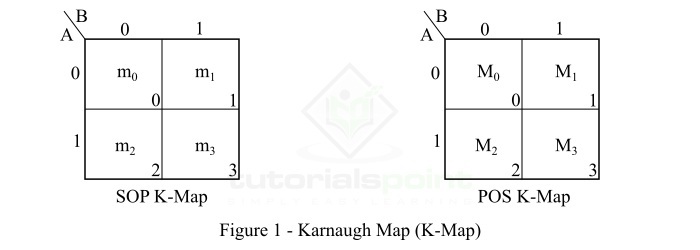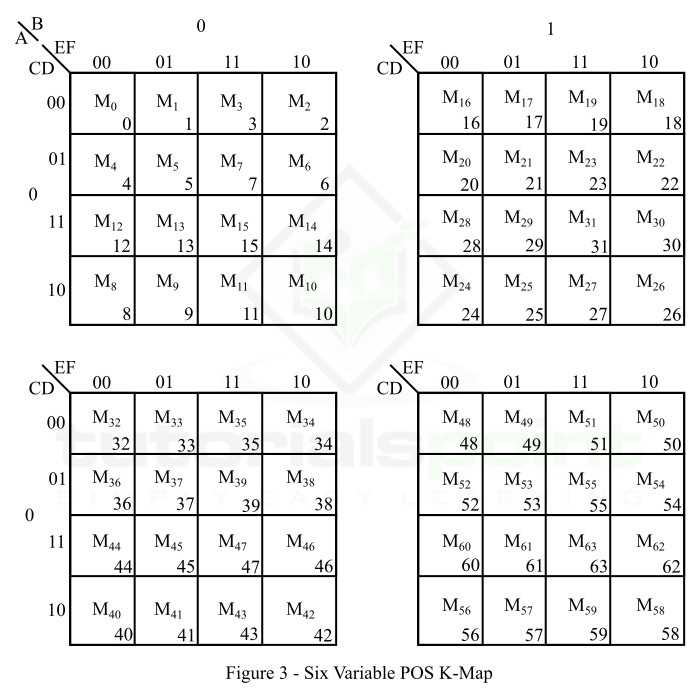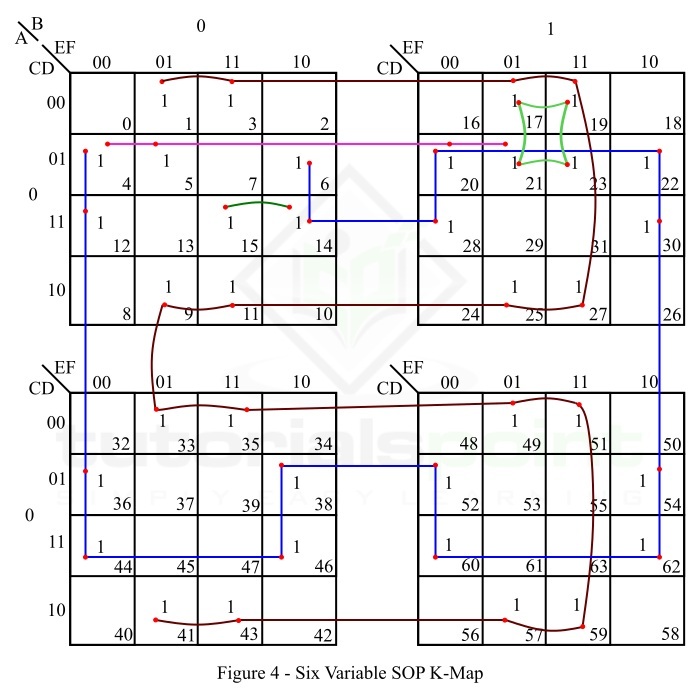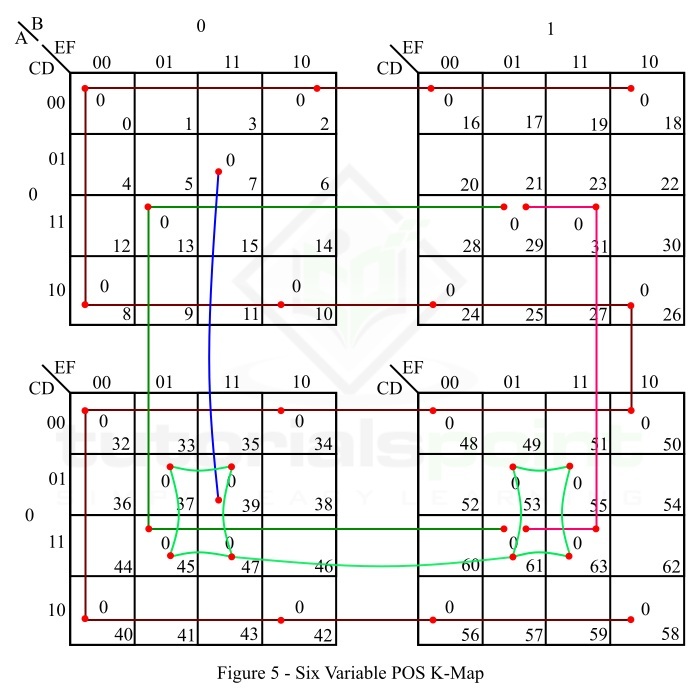Digital-electronics 简明教程
6 Variable K-Map in Digital Electronics
阅读本章,了解如何使用卡诺图(K-Map)将六个变量的布尔函数简化得较小。让我们从卡诺图(K-Map)的简要介绍开始。
Read this chapter to learn how you can use the K-Map (Karnaugh Map) to reduce a Boolean function in six variables. Let’s start with a brief introduction to Karnaugh Map (K-Map).
Karnaugh Map (K-Map)
Karnaugh Map 或 K-Map 是一种将布尔函数简化到最小形式的图形方法。K-Map可定义为由相邻的方块或单元格组成的图表或图形,其中每个单元格表示布尔表达式的变量的特定组合,无论是求和还是乘积形式。一个典型的2变量K-Map在图1中表示。
The Karnaugh Map or K-Map is a graphical method of reducing a Boolean function to its minimal form. The K-Map can be defined as a chart or a graph that is composed of an arrangement of adjacent squares or cells, where each cell represents a particular combination of variables of the Boolean expression either in sum or product form. A typical 2 Variable K-Map is represented in Figure-1.

在实际操作中,我们一般使用最多六个变量的 Karnaugh 图。但是,Karnaugh 图也可用于任意数量的变量,但对于五个或更多变量,它会变得繁琐。
In actual practice, we generally use a K-map upto 6 variables. However, K-map can be used for any number of variables, but for variables 5 or more, it becomes tedious.
现在,我们讨论六变量 Karnaugh 图及其应用,以将布尔函数化简为最小项表达式。
Now, let us discuss the six variable K-map and its application to reduce a Boolean function to the minimal form.
Six Variable K-Map
六变量 Karnaugh 图用来化简六个变量(假设为 A、B、C、D、E、F)的布尔表达式。它有 64(2^6) 个相邻的单元格或方块。其中,每个单元格表示函数中变量的一个组合。
A six variable K-Map is used to reduce a Boolean expression of six variables (say A, B, C, D, E, F). It has 64 (26) adjacent cells or squares. Where, each cell represents a combination of variables of the function.
对于六变量布尔函数的 SOP 形式,输入变量可能的组合如下:
For a 6-variable Boolean function in SOP form, the possible combinations of the input variables are as follows −
\(\bar{A}\bar{B}\bar{C}\bar{D}\bar{E}\bar{F}, \: \bar{A}\bar{B}\bar{C}\bar{D}\bar{E}F, \: \bar{A}\bar{B}\bar{C}\bar{D}E\bar{F}, \: \dots \: ABCDEF\)
\mathrm{\bar{A}\bar{B}\bar{C}\bar{D}\bar{E}\bar{F}, \: \bar{A}\bar{B}\bar{C}\bar{D}\bar{E}F, \: \bar{A}\bar{B}\bar{C}\bar{D}E\bar{F}, \: \dots \: ABCDEF}
这些变量组合的最小项符号分别为 m0、m1、m2…m63。
The minterm designations of these combinations of variables are m0, m1, m2 … m63 respectively.
类似地,对于六变量布尔函数的 POS 形式,输入变量可能的组合如下:
Similarly, for a 6-variables Boolean function in POS form, the possible combinations of input variables are as follows −
\(\mathrm{\left ( A \: + \: B \: + \: C \: + \: D \: + \: E \: + \: F \right ), \: \left ( A \: + \: B \: + \: C \: + \: D \: + \: E \: + \: \bar{F} \right ), \: \left ( A \: + \: B \: + \: C \: + \: D \: + \: \bar{E} \: + \: F \right ), \: \dots \: \left ( \bar{A} \: + \: \bar{B} \: + \: \bar{C} \: + \: \bar{D} \: + \: \bar{E} \: + \: \bar{F} \right )} \)
\mathrm{\left ( A \: + \: B \: + \: C \: + \: D \: + \: E \: + \: F \right ), \: \left ( A \: + \: B \: + \: C \: + \: D \: + \: E \: + \: \bar{F} \right ), \: \left ( A \: + \: B \: + \: C \: + \: D \: + \: \bar{E} \: + \: F \right ), \: \dots \: \left ( \bar{A} \: + \: \bar{B} \: + \: \bar{C} \: + \: \bar{D} \: + \: \bar{E} \: + \: \bar{F} \right )}
这些变量组合的最大项符号分别为 M0、M1、M2,…M63。
The maxterm designations of these combinations of variables are M0, M1, M2, … M63 respectively.
如前所述,六变量 Karnaugh 图有 64 个单元格,分为 4 个块,每个块有 16 个方块。Karnaugh 图上的每个单元格表示一个最小项或最大项。对于六变量 Karnaugh 图,变量 A 和 B 的值在每个 16 个方块的块中的所有最小项(或最大项)中保持相同。
As already mentioned, the six variable K-map has 64 cells which are divided into 4-blocks of 16 squares each. Each cell on the K-map represents a minterm or a maxterm. In the case of 6 variable K-map, the values of variables A and B remain the same for all minterms (or maxterms) in each block of 16 squares.
六变量 Karnaugh 图的 64 个单元格分为 4 个块,如下所示:
The 64 cells of a six variable K-map are divided into 4 blocks as follows −
Block 1 - 这是左上角的块。这个块表示从 m0 到 m15 的最小项(或从 M0 到 M15 的最大项)。在这个块中,变量 A 为 0,变量 B 也为 0。
Block 1 − This is the top left block. This block represents minterms from m0 to m15, (or maxterms from M0 to M15). In this block, the variable A is a 0 and the variable B is also a 0.
Block 2 - 这是右上角的块。这个块表示从 m16 到 m31 的最小项(或从 M16 到 M31 的最大项)。在这个块中,变量 A 为 0,变量 B 为 1。
Block 2 − This is the top right block. This block represents minterms from m16 to m31, (or maxterms from M16 to M31). In this block, the variable A is a 0 and the variable B is a 1.
Block 3 - 这是左下角的块。这个块表示从 m32 到 m47 的最小项(或从 M32 到 M47 的最大项)。在这个块中,变量 A 为 1,变量 B 为 0。
Block 3 − This is the bottom left block. This block represents minterms from m32 to m47, (or maxterms from M32 to M47). In this block, the variable A is a 1 and the variable B is a 0.
Block 4 - 这是右下角的块。这个块表示从 m48 到 m63 的最小项(或从 M48 到 M63 的最大项)。在这个块中,变量 A 为 1,变量 B 也为 1。
Block 4 − This is the bottom right block. This block represents minterms from m48 to m63, (or maxterms from M48 to M63). In this block, the variable A is a 1 and the variable B is also a 1.
在化简时,六变量 Karnaugh 图可能包含 2 方块、4 方块、8 方块、16 方块、32 方块或 64 方块,也可能包括地图的全部四个块。
While simplification, the 6-variable K-map may contain 2-squares, 4-squares, 8-squares, 16- squares, 32-squares, or a 64-square by involving all the four blocks of the map.
在六变量 Karnaugh 图中,当一个块叠加在另一个块的顶部时,另一个块位于第一个块的上面、下面或旁边,并且这些方块彼此重合。那么,这两个块中的方块就被认为是相邻的。同样重要的是要注意,诸如 m10 和 m58、m15 和 m63、m18 和 m34、m29 和 m45 这样的对角线元素彼此不相邻。
In a six variable K-Map, when a block is superimposed on the top of another block, which is either above or below or beside of the first block, and the squares coincide with one another. Then, the squares are considered adjacent in the two blocks. It is also important to note that the diagonal elements such as m10 and m58, m15 and m63, m18 and m34, m29 and m45 are not adjacent to each other.
六变量 SOP Karnaugh 图示于图 2。
A six variable SOP K-map is represented in Figure-2.

六变量 POS Karnaugh 图示于图 3。
A six variable POS K-map is represented in Figure-3.

现在,让我们利用已解决的数值示例来了解六变量 K 映射在最小化六变量布尔函数中的利用。
Now, let us understand the utilization of the six variable K-map for minimization of a six variable Boolean function with the help of solved numerical examples.
Example 1
使用 K 映射最小化以下六变量布尔函数。
Minimize the following 6 variable Boolean function using K-map.
\mathrm{f \: = \: \sum \: m(1, 3, 4, 5, 6, 9, 11, 12, 14, 15, 17, 19, 20, 21, 22, 23,25, 27, 28, 30, 33, 35, 36, 38, 41, 43, 44, 46, 49, 51, 52, 54, 57, 59, 60, 62)}
Solution
给定布尔函数的六变量 SOP K 映射表示如图 4 所示。
The 6-variable SOP K-map representation of the given Boolean function is shown in Figure-4.

该函数的化简按下列步骤进行 −
The reduction of this function is done as per the following steps −
K 映射中没有孤立的 1。
There are no isolated 1s in the K-map.
最小项 m1 与最小项 m3、m9、m11、m17、m19、m25、m27、m33、m35、m41、m43、m49、m51、m57 和 m59 形成一个 16 平方块。将其制成并读作 −
The minterm m1 forms a 16-square with minterms m3, m9, m11, m17, m19, m25, m27, m33, m35, m41, m43, m49, m51, m57, and m59. Make it and read it as −
\mathrm{\bar{D}F}
最小项 m4 与最小项 m6、m12、m14、m20、m22、m28、m30、m36、m38、m44、m46、m52、m54、m60 和 m62 形成一个 16 平方块。将其制成并读作 −
The minterm m4 forms a 16-square with minterms m6, m12, m14, m20, m22, m28, m30, m36, m38, m44, m46, m52, m54, m60, and m62. Make it and read it as −
\mathrm{\bar{F}D}
最小项 m5 可以与最小项 m4、m20 和 m21 形成一个 4 平方块,或与 m1、m17 和 m21 形成一个 4 平方块。我们将其与最小项 m4、m20 和 m21 制成,并读作 −
The minterm m5 can form a 4-square with minterms m4, m20, and m21, or with m1, m17, and m21. We will make it with minterms m4, m20, and m21, and read it as −
\mathrm{\bar{A}\bar{C}D\bar{E}}
最小项 m21 与最小项 m17、m19 和 m23 形成一个 4 平方块。将其制成并读作 −
The minterm m21 forms a 4-square with minterms m17, m19, and m23. Make it and read it as −
\mathrm{\bar{A}B\bar{C}F}
最小项 m15 可以与最小项 m11 或 m14 形成一个 2 平方块。我们将将其与 m14 制成,并读作 −
The minterm m15 can make a 2-square with the minterm m11 or m14. We will make it with m14, and read it as −
\mathrm{\bar{A}\bar{B}CDE}
将所有乘积项写成 SOP 形式。
Write all the product terms in SOP form.
因此,最小 SOP 表达式为:
Therefore, the minimal SOP expression is,
\mathrm{f \left ( A,B,C,D,E,F \right ) \: = \: \bar{D}F \: + \: D\bar{F} \: + \: \bar{A}\bar{C}D\bar{E} \: + \: \bar{A}B\bar{C}F \: + \: \bar{A}\bar{B}CDE}
Example 2
利用卡诺图法最小化以下六个变量布尔函数。
Minimize the following six variable Boolean function using K-map.
\mathrm{f \: = \: \Pi \: M(0, 2, 7, 8, 10, 13, 16, 18, 24, 26, 29, 31,32, 34, 37, 39, 40, 42, 45, 47, 48, 50, 53, 55, 56, 58, 61, 63)}
Solution
给定布尔函数的六变量 POS 卡诺图表示如图 5 所示。
The 6-variable POS K-map representation of the given Boolean function is shown in Figure-5.

该函数的化简按下列步骤进行 −
The reduction of this function is done as per the following steps −
卡诺图中没有孤立的 0。
There are no isolated 0s in the K-map.
极大项 M0 与极大项 M2、M8、M10、M16、M18、M24、M26、M32、M34、M40、M42、M48、M50、M56、M58 构成 16 个方块。将其制成和式并将其读作 −
The maxterm M0 forms a 16-square with maxterms M2, M8, M10, M16, M18, M24, M26, M32, M34, M40, M42, M48, M50, M56, M58. Make it and read it as −
\mathrm{\left ( D \: + \: F \right )}
极大项 M37 与极大项 M39、M45、M47、M53、M55、M61 和 M63 构成 8 个方块。将其制成和式并将其读作 −
The maxterm M37 forms an 8-square with maxterms M39, M45, M47, M53, M55, M61, and M63. Make it and read it as −
\mathrm{\left (\bar{A} \: + \: \bar{D} \: + \: \bar{F} \right )}
极大项 M13 与极大项 M29、M45 和 M61 构成 4 个方块。将其制成和式并将其读作 −
The maxterm M13 makes a 4-square with maxterms M29, M45, and M61. Make it and read it as −
\mathrm{\left(\bar{C} \: + \: \bar{D} \: + \: E \: + \: \bar{F} \right )}
极大项 M31 与 M29、M61 和 M63 构成 4 个方块。将其制成和式并将其读作 −
The maxterm M31 makes a 4-square with M29, M61, and M63. Make it and read it as −
\mathrm{\left( \bar{B} \: + \: \bar{C} \: + \: \bar{D} \: + \: \bar{F} \right )}
极大项 M7 与极大项 M39 构成 2 个方块。将其制成和式并将其读作 −
The maxterm M7 forms a 2-square with the maxterm M39. Make it and read it as −
\mathrm{\left( B \: + \: C \: + \: E \: + \: \bar{D} \: + \: \bar{E} \: + \: \bar{F} \right )}
以 POS 形式书写所有和式。
Write all the sum terms in POS form.
因此,给定布尔函数的最小 POS 表达式为,
Thus, the minimal POS expression for the given Boolean function is,
\mathrm{f \left ( A,B,C,D,E,F \right ) \: = \: \left ( D \: + \: F \right )\left ( \bar{A} \: + \: \bar{D} \: + \: \bar{F} \right )\left( \bar{C} \: + \: \bar{D} \: + \: E \: + \: \bar{F} \right )\left( \bar{B} \: + \: \bar{C} \: + \: \bar{D} \: + \: \bar{F} \right )\left( B \: + \: C \: + \: E \: + \: \bar{D} \: + \: \bar{E} \: + \: \bar{F} \right )}
这就是关于六变量卡诺图及其在布尔函数最小化中的应用。尝试解决以下教程问题,以精通六变量卡诺图及其在化简布尔表达式的应用概念。
This is all about six variable K-map and its application in minimization of Boolean functions. Try solving the following tutorial problems to excel in the concept of six variable K-map and its application to reduce Boolean expressions.
Numerical Problems on K-Map
Q. 1 − 利用卡诺图法按 SOP 形式最小化以下六变量布尔函数。
Q. 1 − Minimize the following six variable Boolean function in SOP form using K-map.
\mathrm{f \left ( A,B,C,D,E,F \right ) \: = \: \sum m(1, 3, 5, 7, 9, 10, 11, 12, 14, 16, 17, 19, 20, 22, 24, 25, 26, 31, 32,34, 36, 37, 39, 40, 42, 45, 49, 50, 53, 54, 57, 60, 61, 63)}
\mathrm{f \left ( A,B,C,D,E,F \right ) \: = \: \sum m(1, 3, 5, 7, 9, 10, 11, 12, 14, 16, 17, 19, 20, 22, 24, 25, 26, 31, 32,34, 36, 37, 39, 40, 42, 45, 49, 50, 53, 54, 57, 60, 61, 63)}
Q. 2 ——最小化 6 个变量布尔函数在 POS 中的 K 图形式
Q. 2 − Minimize the following six variable Boolean function in POS form using K-map.
\mathrm{f \left ( A,B,C,D,E,F \right ) \: = \: \Pi M(0, 1, 3, 4, 5, 6, 8, 9, 10, 12, 14, 15, 17, 20, 21, 22, 25, 26, 27,29, 30, 32, 33, 35, 36, 37, 39, 40, 41, 42, 45, 47, 48, 50, 52, 53, 55, 56, 58, 59, 60, 62 )}